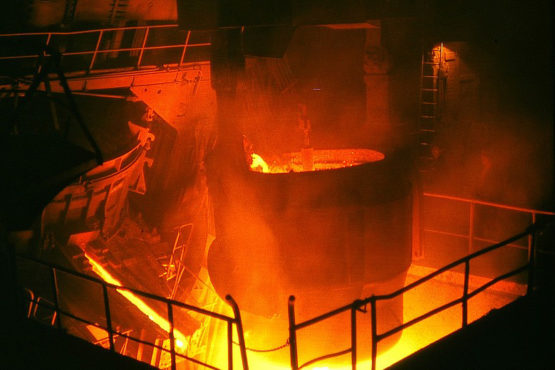Study outlines five thermal energy grand challenges for decarbonizing the world’s economy
Almost all of the world’s energy use involves heat, from making steel to refrigerating food. Deep decarbonization without breakthroughs in thermal science and engineering seems inconceivable. Three leaders in the area highlight five important topics to explore.
Solar and wind power are an important part of solving the problem of climate change, but these renewable technologies on their own probably will never provide the energy for many industrial processes, like making steel.
Approximately 90 percent of the world’s energy use involves generation or manipulation of heat, including the cooling of buildings and food. Maintaining modern economies and improving life in developing economies while mitigating climate change will require five major advances in how we convert, store and transmit thermal energy, according to a new paper in Nature Energy from Stanford University, Massachusetts Institute of Technology and Lawrence Berkeley National Laboratory.
“Modern renewable technologies are the most inexpensive source of electricity we have today, but solar and wind power are intermittent and account for a small percentage of the world’s energy,” said Arun Majumdar, one of three co-authors and a Stanford professor of mechanical engineering. “We need to increase this percentage, but we also must decarbonize heat and use heat to store electricity from solar and wind.”
The analysis underscores the urgent need to research and develop thermal technology breakthroughs that potentially could reduce greenhouse gas emissions by at least one gigaton, which is about 3 percent of annual energy-related GHG emissions globally.
“We as a species are endangering ourselves with the infrastructure we have erected to improve our quality of life,” said co-author Asegun Henry, associate professor of mechanical engineering at MIT. “There are a few instances in history when scientists and engineers have come together and achieved something very remarkable in very short timeframes. This must be one of those times.”
Heat as energy storage
One major challenge in thermal engineering is to store excess wind and solar power as heat energy over multiple days and then convert it back into electricity when needed. The full decarbonization of electricity would reduce man-made, global GHG emissions by about a fourth. Getting 70 percent or more of our electricity from intermittent renewables will require massive additions of electricity storage. Expanding the most common current technology, pumped hydroelectric storage, is limited by geography, and lithium-ion batteries are too expensive for storing excess renewable power over multiple days.
“The key advantage for thermal energy storage is its potential for low cost at large scale,” said co-author Ravi Prasher, associate laboratory director for energy technologies at Lawrence Berkeley National Laboratory.
“While it is relatively easy to convert electricity to heat,” Prasher explained, “the key challenge for thermal energy storage is the large efficiency penalty when converting heat back to electricity.”
Several thermal energy storage technologies at large scale are still in early development, so competing technologies using other thermal storage materials and mechanisms must continue to be explored, the researchers conclude.
“Even though the round-trip efficiency maybe only 50 percent to 60 percent, the cost could be within the needed range of less than $10 per kilowatt-hour,” said Majumdar, who is also a co-director of Stanford’s Precourt Institute for Energy.
Industry and refrigeration
Another grand challenge is generating the extreme heat needed in industrial processes, like making cement, steel, aluminum and hydrogen. GHG emissions in the industrial sector comprise more than 15 percent of global emissions, the majority of which are associated with providing heat at temperatures of 100 to 1,000 degrees Celsius, (212 to 1,832 degrees Fahrenheit).

Iron being smelted in a steel mill furnace at 1,500 degrees Celsius (2,732 degrees Fahrenheit). (Image credit: Eugen Nosko)
With the rapidly decreasing cost of renewable electricity and potentially GHG-free hydrogen, the industrial sector could conceivably be decarbonized by using either resistive heaters or hydrogen combustors, according to the analysis. Significant science and engineering challenges, however, still remain. For intermittent renewable electricity, either cheap high-temperature storage or low capacity factor furnaces need to be developed.
A third grand challenge is on the opposite side of the thermal spectrum from heat: refrigeration. The goal is to invent refrigerants for both food and air conditioning without today’s leakage of hydrofluorocarbons, a set of extremely powerful greenhouse gases. Successful new refrigerants must be non-flammable, non-toxic and affordable, as well as preferably drop-in solutions to today’s systems, said Majumdar.
“With the rise of refrigeration and cooling in emerging economies, this is a major challenge,” Henry said.
In many developing economies the growing demand for air conditioning is about reducing humidity as much as temperature, so new refrigerants will have to accomplish this as well, said Prasher. Alternatively, new technologies could be developed to decouple dehumidification from cooling.
Buildings and heat transport
Space and water heating in both residential and commercial buildings are responsible for more than 6 percent of U.S. GHG emissions. New building materials that can both conduct heat and block it – on demand – are needed to reduce energy for heating and cooling. The ability to control thermal conductance in a building’s shell could save 10 percent to 40 percent of GHG emissions, so this represents another worthy challenge to tackle, the researchers say.
Lastly, a particularly large challenge is to develop the ability to transmit heat over long distances with little loss of energy. This is achieved with steam today, but that is not at the scale or distance needed. The goal here is to develop the heat equivalent of an electrical power line – an effective method for transporting large megawatt-scale heat using minimal equipment and materials. The discovery of a thermal superconductor could enable this, but the practicality of deploying one on a large scale is not clear. Another potential research avenue, according to the researchers, is to discover new pumpable fluids with reversible chemical reactions to transmit energy in chemical, rather than thermal, form.
“Deep decarbonization without breakthroughs in thermal science and engineering seems inconceivable, but attention from researchers and funders hasn’t reflected that,” said Majumdar. “We hope this analysis will be a call to action for the broader R&D community.”
Arun Majumdar is also a professor of photon science at SLAC National Accelerator Laboratory.
To read all stories about Stanford science, subscribe to the biweekly Stanford Science Digest.

